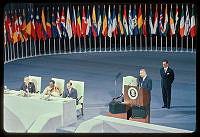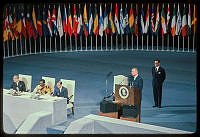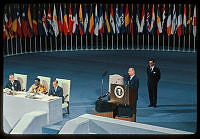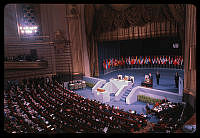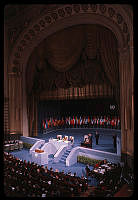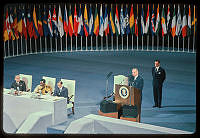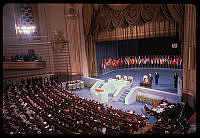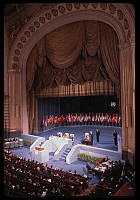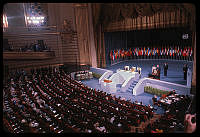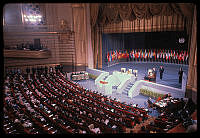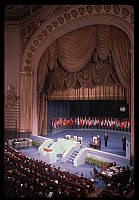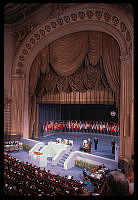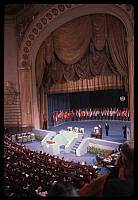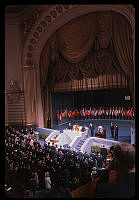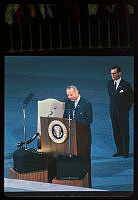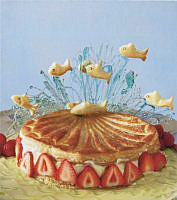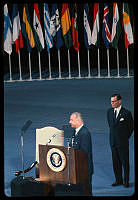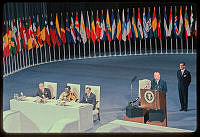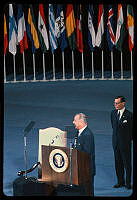Romantic Expansions
Looking West from the White House
Copyright © Fall 2013 White House Historical Association. All rights reserved under international copyright conventions. No part of this article may be reproduced or utilized in any form or by any means, electronic or mechanical, including photocopying, recording, or by any information storage and retrieval system, without permission in writing from the publisher. Requests for reprint permissions should be addressed to books@whha.org

Old Faithful by Albert Bierstadt, c. 1881, oil on canvas.
In our own time thoughts about “the West” have been rather vividly colored by popular culture imagery depicting the rugged individual in mortal conflict with a violent and unyielding terrain. But for many artists and writers of the nineteenth century the West was more an ideal destination than a specific locale. As the nascent United States began to expand westward from the original colonial boundaries, the imaginations of politicians and creative individuals were inspired by the possibilities and challenges of western expansion. After all, the White House was the first structure in the nation’s capital to be built west of the Capitol building. Indeed Samuel Blodget’s elevation of the west end of the White House features the very window from which the chief executive could look out toward the unseen but burgeoning country spreading toward the setting sun.
Thomas Jefferson might be considered the Founding Father of western
growth. His efforts to secure the travel and trade routes of the
Mississippi River Valley for American interests culminated in the
Louisiana Purchase of 1803. That acquisition more than doubled the size
of the country by adding some 828,000 square miles of land, much of it
virgin, arable, territory, which enhanced the assets of the national
economic foundation. The third president was an agrarian. He had written
that those “who labor in the earth are the chosen people of God, if
ever he had a chosen people, whose breasts he has made his peculiar
deposit for substantial and genuine virtue. It is the focus in which he
keeps alive that sacred fire, which otherwise might escape from the face
of the earth.”1As
may be expected from the mind of Jefferson, the subtle question as to
whether God “had a chosen people” opens an interesting dialogue on man,
nature, and the first American western frontier. Were the
westward-moving pioneers spiritual pilgrims in a new Eden, bright with
the promise of prosperity and abundance, or secular emissaries seeking
to exploit the natural resources of a virgin wilderness?
This perennial rebirth, this fluidity of American life, this expansion westward with its new opportunities, its continuous touch with the simplicity of primitive society, furnish the forces dominating American character.
Two of the nation’s most important historical genre painters, George Caleb Bingham and William Tylee Ranney, addressed those concerns in their illustrative works on the topic of Daniel Boone’s progress into the Kentucky territory. Both artists were painting in the flush days of American romanticism, an age that celebrated the exploratory ventures of men like Boone by spinning their exploits in biblical terms. That is how Lyman Draper, who interviewed Boone, described Boone’s first view of Kentucky. “At length he ascended the eminence and with joy and wonder beheld the beautiful landscape of Kentucky spread out invitingly before him. Boone must have felt something as Moses did when he toilingly reached Pisgah’s lofty summit and had a distant view of the promised land throughout its whole extent, with, however, this important difference, that the Lord’s prohibition of Moses ever going thither did not happily apply in Boone’s case.”2
Ranney’s painting suggests Boone was a spiritual pilgrim. His painting may well have been inspired by Timothy Flint’s Biographical Memoir of Daniel Boone, published in 1847. Flint’s work was part of an effort to idolize Boone as “an heroic figure who, despite his common origins, manifested the energy of divine intercession in the triumphant national march to the West.”3 This apotheosis raised Boone from pioneer to prophet, one who stands, like Moses, upon a precipitous ledge surveying a promised land just out of sight in the golden light beyond the towering trees, one who has gone to the mountain, seen the other side, and stands in silent serenity. In this scenario, popular in the 1840s, Boone became an iconoclast, one who sought freedom from the social construct in the wilderness, evident by his own expressed longing to keep moving beyond the confines of civilization. Like Henry David Thoreau, he went to the woods. And so Ranney’s painting presents Boone as a “fine contrast to the development elsewhere induced by the spirit of trade and political ambition.”4
That “spirit of trade and political ambition” was certainly embodied by the expansionist Whig politics of four-time White House contender Henry Clay and his follower the artist George Caleb Bingham. As the progenitor of the American System, Clay envisioned a cultivation of the western frontier through public funding of building projects beneficial to private enterprise. It is in that spirit that Bingham’s Boone sets forth across the mountains. Blurring all fact, Bingham created a painting presenting western expansion as a family matter, ordained by God, with Whig consensus, pursued by man, nurtured by the fertile presence of womankind, and secured in Kentucky.

George Caleb Bingham’s Lighter Relieving a Steamboat Aground, 1847, oil on canvas, hangs in the White House Green Room.
White House Historical AssociationBoone and party proceed through the yawning gap, exaggerated in density, scale, and threat as though he were Moses parting the seas. He leads a horse bearing his wife, serenely cast as an allegorical Renaissance Madonna, her head discreetly covered, her hands demurely folded, with all the air of a high baroque religious painting of the rest on the flight to Egypt in the manner of the seventeenth-century northern European school. The settlers pause at a critical juncture, further emphasized by the on-point attention of the dog in the lower left.
Boone and his tribe pass the gap in a dramatically confrontational composition, figures coming straight toward the viewer, as though moving out of the picture plane. The notion of “Manifest Destiny” is richly embellished through this confrontational composition, one posing the subliminal suggestion that out of the past the historical moment comes resounding into the present, one “said to represent a progressive nationalistic perspective that typified the best in Whig ideology of the late 1840s and early 1850s.”5
Bingham’s and Ranney’s paintings in the White House collection vibrantly portray the romance of western expansion as experienced in symbol and fact. Bingham’s Lighter Relieving a Steamboat Aground recalls the age of “venturesome flatboats that drifted with the current, its picturesque rivermen, ‘half horse, half alligator,’ who towed their heavy crafts upstream, its rude miscellany of settlers who entrusted their families, and goods and cattle to great rafts and set forth hopefully on waters that were to bear them . . . to the Promised Land.”6 The artist employs a bold, daring geometry and, again, a confrontational figural placement. His most important biographer, Maurice Bloch, regards these elements as hallmarks “of his thinking as a painter of the western scene.”7

Boys Crabbing by William Tylee Ranney, 1855, oil on canvas.
While Ranney’s painting of Boys Crabbing has a less obvious reference to the territorial West, the symbolic importance of western light—the light of opportunity—is apparent in the richly glowing sky. Ranney’s ruddy boys atop their rustic pier are embodiments of a national archetype, seen in art and to be read in literature as “healthy country boys working on the farm, engaged in vigorous play, and even making mischief” who “function as indicators of the well-being of American democracy.”8 While their immediate focus is upon the catch at hand, the day is passing peacefully, the atmospherics of the scene are intimations of a warmth and harmonic wholeness in which the cycles of life, seeking and finding, may be rewarded.
The promise of abundance is inherent in the ambitious intent of western expansion. In his memoirs Boone found the first western frontier to be a “series of wonders, and a fund of delight. Here she displayed her ingenuity and industry in a variety of flowers and fruits, beautifully colored, elegantly shaped, and charmingly flavored.”9 The still life paintings of this era richly reflect that spirit of gracious plenty. The art of Severin Roesen, whose return to art-historical interest was spurred by First Lady Jacqueline Kennedy’s decision to include his work in the renewed White House interiors, is emblematic of the spirit of the times. When we view his art our gaze is riveted by an organic congregation that powerfully implies a deeper, more transcendental meaning than mere imitation of nature or a random harvest.

Emigrant Scene, c. 1837, attributed to William Henry Powell, oil on canvas, hangs in the West Wing, c. 2004.
White House Historical AssociationThe work of Bingham and Ranney may be considered historical genre paintings colored with an agrarian idealism implicit in the American romantic movement. At the same time, other artists, notably James Henry Beard and his student William Henry Powell, were painting evocative renditions of ordinary daily life. Beard’s characterizations place him in the vanguard of mid-century American genre painters who observed and depicted the complex vitality of the social contruct in which they lived even as that vitality became increasingly charged with debates on slavery and economic development. Powell’s Emigrant Scene is a fascinating rendition of the potential for conflict between the migrating settlers and the Native Americans. Whereas Boone’s pioneers march triumphantly toward the view, Powell’s settlers bustle about in disarray before an observant Native American whose back is turned toward the viewer. By that compositional format Powell asks a subtle question: Can we, like the native, quite comprehend the full implication of departure into yet another “new world”?
By the time of the Civil War the focal point of “the West” had shifted toward those lands beyond the Mississippi. Thematically it was a shift from the Near West to the Far West, from the comforting ideas of agrarianism to the overwhelming demands of the vast prairies with their limitless sense of space, lurking danger, and sublime scenic wonders. The role of the artist changed as well, from the visionary creator to the artistic explorer, occupied by the more traditional topographical concerns of landscape art. The critic Henry Tuckerman vividly described the challenge to contemporaneous artists when he invoked the spirit of the West as a place where “life assumed a new aspect and nature presented striking phases,” where one saw “majestic rivers flowing through almost interminable woods; seas of verdure covered with bright and nameless flowers . . . and towering mountain cliffs.”10 Among the artist-explorers who accepted that challenge were Albert Bierstadt, Thomas Hill, Thomas Moran, and Worthington Whittredge.

Rocky Mountain Landscape by Albert Bierstadt, 1870, oil on canvas.
White House Historical Association/White House CollectionBierstadt was a German-born artist who accompanied an expedition led by Colonel Frederick Lander in 1859. On that trip he made sketches he later translated into a series of monumental paintings that enjoyed great popularity in the United States and abroad. His emotive view of 1870, Rocky Mountain Landscape, celebrates a conjunction of space and light with a quiet, almost religious dignity. Ranney’s Boone stood on a precipice looking, like Moses, toward a promised land; Bierstadt’s viewer stands dwarfed and entranced by a towering mountain whose thunderous heights imply a sanctity associated with the heights of Sinai where Moses beheld the very splendor of God. A later painting of Old Faithful, continues the adoration of that reliable natural phenomenon, forever enshrined in the national park whose creation in 1872 was partially inspired by Bierstadt and his contemporaries.
Thomas Hill created vast panoramic art that brought the Yosemite Valley of California to broad public attention. After an initial visit there in 1862, he studied in Paris and worked in Boston before moving to San Francisco in 1871. Once in California he became “the painter of Yosemite, even building a studio there in 1883 to minimize the still arduous approach to the valley.”11 One of his first efforts, View of the Yosemite Valley (1865), came to the attention of chromolithographer Louis O. Prang, who issued it in popular chromolithographic form. His 6 x 10 foot painting of the valley view was exhibited at the Philadelphia Centennial in 1876, earning the artist a gold medal for landscape art.12

Vernal Falls, Yosemite by Thomas Hill, 1889, oil on canvas.
White House Historical Association/White House CollectionVernal Falls, Yosemite is one of several images the artist created of the rushing waters falling from the valley’s precipitous ledge. This painting offers an interesting counterpoint to Hill’s huge, dramatically staged canvases intended for mass public viewing. Here the smaller scale and looser brushwork result in a deeply personal image, a personal glimpse into a site of scenic wonder. The viewer’s eye is lifted up and over the multiple rocky outcroppings toward the towering summit behind which looms an evanescent glimpse of mountainous height. His dramatic contrast of primal elements may indicate his awareness of the English aesthete John Ruskin’s articulation of the romantic sublime in landscape painting, his admiration for a “jet of spray” that “leaps hissing out of the fall, like a rocket, bursting in the wind and driven away in dust, filling the air with light.”13
Thomas Moran accompanied the geologist Ferdinand Hayden west in 1871, funded, in part, by the financier Jay Cooke and Scribner’s Monthly. On that excursion Moran made sketches and watercolors of more than thirty sites later rendered into a series of paintings. As early as 1872 he exhibited a watercolor of the cliffs of the Green River in Wyoming, which the New York Post cited as a “study from nature” in which “red or blood-covered lava, which as it has become disintegrated by the action of the atmosphere runs down its perpendicular side, one color mingling with another in rich confusion, until the base it assumes a gray-green tone of surpassing brilliancy.”14

Cliffs of Green River, Wyoming by Thomas Moran, 1909–10, oil on canvas.
White House Historical Association/White House CollectionMoran subsequently painted several versions of his renowned revelation of grandeur in isolation. Following an exhibition in 1901, the critic W. P. Lockington wrote that “there is no better exponent of God’s own architecture” than Moran, whose representation spans “the base to the pinnacle” capturing “the volcanic upheaval and descendant stand in sullenness and pride, dignified and morose . . . unintelligible . . . unconquered” and “brought nearer home by Mr. Moran, than by any other artist through the length and breadth of the land.”15
Of all these artists, Worthington Whittredge is the one most associated with the luminist style of the Hudson River School.16 The luminist artists held a transcendental interest in the interaction of the effects of light and air upon bodies of water as reflected over the landscape. In their art light is both a tool of observation and the very observation itself. Whittredge’s Crossing the River Platte dissolves the massive form of the Rocky Mountain range in the background into the shimmering light of the water far below. It may well be that he “painted with the tones of a lyric poet, not an epic one. Through mood rather than narrative the domestic serenity of the encampment” suggests an integral harmony between man and nature.17 Here, too, is a subtle suggestion of a quiet interaction between the native and the interloper, a small, indeed perhaps insignificant, drama, acted out on a vast stage whose size the audience can only imagine.

Crossing the River Platte by Worthington Whittredge, c. 1871, oil on canvas.
White House Historical Association/White House CollectionAt the end of the day we might recall that the landscape art of “the West,” whether allegorical or topographic, is a product of the painter’s imagination and not the camera’s lens. The light in those painterly western skies rises at the dawn of a young republic’s expanding frontier and sets amid the nostalgic longings for pastoral idealism as that frontier closed. John Ross Key’s view of the capital city as seen from Arlington House is a backward glance toward those ideas, illuminated by the light of the West, a light full with the promise of prosperity, abundance, and peace. In the same age in which Key painted, Frederick Jackson Turner penned his great thesis that “expansion westward with its new opportunities, its continuous touch with the simplicity of primitive society, furnish the forces dominating American character.”18 Their creative understanding of that expansion still speaks to the ongoing debate about growth, opportunity, and the territorial arrangements of the national psyche.









